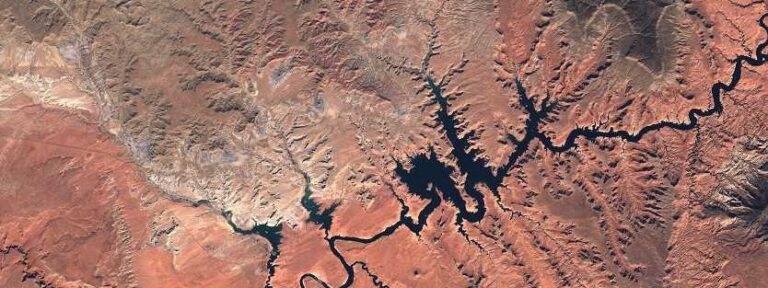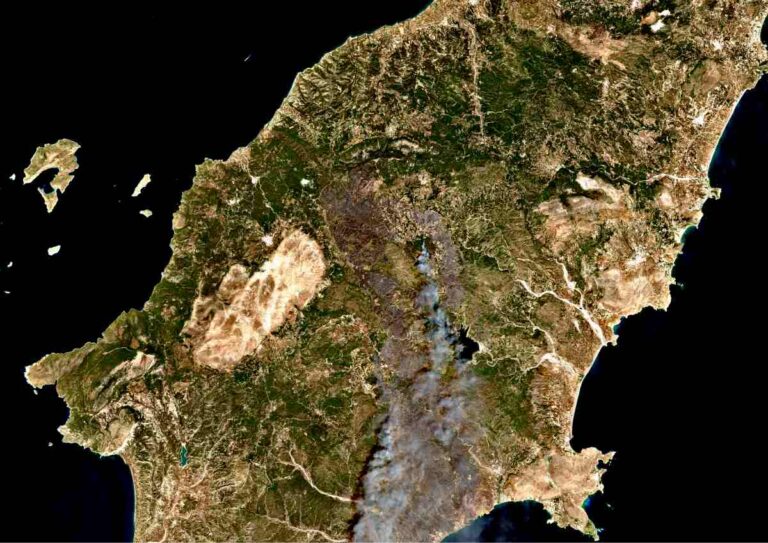Enhancing Earth Observation capabilities - satellite data applications and implications
By Maciej Myśliwiec, Planet Partners
The view from space offers an expanded perspective on Earth. It is remarkable how data can be obtained and comprehended through satellite-based Earth observation. Sixty-five years after the launch of the first artificial satellite, space technology continues to provide an immense volume of data utilized by analysts and scientists worldwide, enabling the development of solutions across various disciplines. Let us explore the breadth of observations that can be done from space!
Currently, over 4,500 artificial satellites orbit our planet. Among them, there are the satellites of the European Union’s Copernicus programme – the leading provider of satellite data in Europe. Each day Copernicus delivers over 12 terabytes of data that is freely accessible to all users. With a simple internet connection, one can access the extensive collection of satellite images gathered since the programme's inception in 2014, with the launch of the first Sentinel-1A satellite.
Managing and processing such vast amounts of data necessitates substantial computational and storage resources. Earth Observation (EO) platforms like CREODIAS provide users with the means to transform EO data into valuable information. CREODIAS currently houses a repository of over 34 petabytes of data and an integrated cloud computing environment, enabling efficient processing of EO data.
Presently, half a million users of the Copernicus programme process more than 16 terabytes of data daily. To put this into perspective, 1 terabyte equates to approximately 250,000 photos captured by a 12-megapixel camera or 500 hours of high-definition video footage. Hence, we speak of millions of images and substantial quantities of other data (e.g., from satellite sensors) generated within the European programme every single day. The easy accessibility of satellite data fuels innovation across various industries and scientific domains. The current market turnover for Earth observation data is estimated at €2.8 billion, with over 41% of the European industry relying on data obtained from Earth observation programmes.
In recent times, several initiatives have emerged to facilitate data access and processing for scientists, researchers, public administrations, the private sector, and the general public. One of these initiatives is the Copernicus Data Space Ecosystem, which aims to provide comprehensive spatial and temporal coverage of Copernicus EO data, immediately accessible to all users free of charge, along with cloud computing resources for further data processing. Another notable initiative is Destination Earth, the flagship project of the European Commission that strives to develop an advanced digital model of the Earth powered by European supercomputers (HPC) and state-of-the-art artificial intelligence technologies.

The convenient access to current and historical Earth Observation data enhances planning and decision-making across diverse fields. How can we leverage these vast resources of satellite data?
Environmental research and climate change
One of the primary applications that come to my mind is the study of climate change and meteorology. EO data plays a crucial role in developing meteorological models for weather forecasting, preparing for and mitigating natural disasters, as well as monitoring and addressing climate change.
Accurate knowledge of current land cover and land use is pivotal for effective planning and management by local and regional authorities. Areas under the jurisdiction of public administration institutions, such as national parks, wetlands, lakes, riverbeds, and coastlines, benefit immensely from open satellite data captured by Sentinel-1 and Sentinel-2 satellites. These data offer extensive possibilities for managing such areas with minimal effort. Even 10-meter multispectral data is sufficient for a range of environmentally significant applications, including drought monitoring, flood management, freshwater ecosystem health assessment, forest cover analysis, biodiversity monitoring, air quality monitoring, and land surface temperature analysis.
Sentinel satellite missions, part of the European Copernicus programme, have revolutionized Earth research since 2014. The ubiquitous availability of freely accessible satellite data is complemented by specialized tools that enable their processing and analysis, converting raw data into actionable information.
Illustrative examples of climate change analysis tools include:
- "Global temperature trend monitor": an application that monitors global air temperature changes on Earth's surface over recent decades.
- "Climate monitoring and volcanic eruptions": an application studying volcanic eruptions, which can cause short-term climate effects on a global and regional scale, contributing to natural climate variability.
- "European temperature statistics derived from climate projections": an application providing European temperature statistics for historical periods (1976-2005) and projected 30-year periods (2031-2060 and 2071-2100) under different climate change scenarios.
These applications represent a fraction of the vast array of possibilities available to users of satellite data programs, tailored to address their specific research inquiries.
Forestry
Most forests are managed by state-owned enterprises for timber production, which significantly contributes to national budgets. Effective forestry management requires comprehensive knowledge of soil characteristics, water dynamics, climate conditions, and microclimates across expansive and sometimes challenging-to-access areas. Satellite data offers valuable insights into forest dynamics and their influence on climate patterns. Real-time spaceborne data serves as an invaluable tool for locating forest fires, monitoring plant diseases, and assessing the impact of drought on tree health.
Agriculture
Earth Observation supports various agricultural processes. At the local level, data assists in identifying optimal locations for cultivation, predicting crop yields, and maintaining records of agricultural parcels. Advanced remote sensing techniques, such as Synthetic Aperture Radar (SAR) and hyperspectral analysis, are increasingly being applied in precision agriculture. At regional or national scales, EO data facilitates land cover classification and supports the implementation of programs aimed at agricultural development and direct subsidies for farmers.
Spatial planning
Satellite data plays a vital role in spatial planning for both urban and rural landscapes. Leveraging EO data, one can conduct detailed surveys and complex analyses of areas of interest. Currently, imagery serves as a primary source of information for formulating up-to-date spatial development plans, considering changes in land use and cover, identifying new areas for investment, and detecting wetland areas. Copernicus Sentinel-2 data, for instance, provides rapid and comprehensive insights into current and historical phenomena. Investors seeking to expand their activities in remote regions greatly benefit from information on the status of potential investment areas.
Urban heat islands
Satellite-based Earth observation data also contributes to urban management, including the monitoring and mitigation of urban heat islands, characterized by significantly higher air temperatures within urban areas compared to adjacent rural regions. Unlike traditional point-based air temperature measurements from monitoring stations, satellite data enables the measurement of surface temperatures at any location within a city. This capability facilitates the development of spatial patterns critical for understanding the phenomenon and aids local authorities in taking necessary measures to improve residents' quality of life.
Maritime transport and logistics
Satellite imagery plays a crucial role in the monitoring and detection of vessel traffic on seas and oceans. It also supports the management of maritime economies and ensures the safe transportation of valuable commodities such as liquefied chemicals and crude oil. In the event of accidents, EO images provide timely assistance in mapping the consequences. Combining EO data with Automatic Identification System (AIS) information yields a powerful tool for monitoring marine objects and phenomena, including coastal monitoring and analysis of changing water depths.
Crisis management
Natural disasters like floods, wildfires, and storms often have a wide spatial extent. Open satellite data forms the foundation for the detection and monitoring of such events. Specialized methods, relying on environmental and atmospheric satellite data, are employed to detect favourable conditions and early warning signs of potential natural hazards like droughts or algal blooms in lakes or seas. Synthetic Aperture Radar (SAR) image processing is recommended for monitoring land movement, particularly for applications such as landslide risk detection, vital for mining and mountain tourism. Very high-resolution data plays a crucial role in assessing building disasters, managing mass events, and ensuring the security of government and military facilities.

Natural disasters like floods, wildfires, and storms often have a wide spatial extent. Open satellite data forms the foundation for the detection and monitoring of such events. Specialized methods, relying on environmental and atmospheric satellite data, are employed to detect favourable conditions and early warning signs of potential natural hazards like droughts or algal blooms in lakes or seas. Synthetic Aperture Radar (SAR) image processing is recommended for monitoring land movement, particularly for applications such as landslide risk detection, vital for mining and mountain tourism. Very high-resolution data plays a crucial role in assessing building disasters, managing mass events, and ensuring the security of government and military facilities.
Satellite imagery provides an insightful perspective on the locations and magnitudes of flooding events. These visual data enable the identification of inundated regions, assessment of soil and vegetation moisture levels, and the prediction of areas potentially vulnerable to flash floods. Earth Observation platforms like CREODIAS house an extensive array of such images, inclusive of superior-resolution datasets from esteemed programs such as Copernicus. Users have the opportunity to peruse diverse images, categorize them chronologically or geographically, and thus acquire a more profound comprehension of flood dynamics.
When combined with ground-level measurements, satellite-based remote sensing offers an in-depth perspective on global drought trends. Meteorological satellites play a crucial role in monitoring key environmental indicators such as humidity, temperature, and wind, which help predict periods of limited rainfall that can subsequently lead to dry soil conditions and stressed vegetation, commonly referred to as agricultural droughts. To support this analysis, the Copernicus programme provides an array of tools tailored to drought assessment. When it comes to hydrological droughts, which signify water shortages within certain regions, advanced satellite imagery becomes indispensable. One of the standout techniques in this domain is SAR – Synthetic Aperture Radar, which is a type of radar imaging that uses radio waves to capture detailed images of the Earth's surface, making it possible to detect even subtle changes in water levels and providing valuable insights into drought conditions.
Assessment of war-related environmental damage
Satellite data proves invaluable during wars and armed conflicts. However, its utility extends beyond military applications. By processing data, it becomes possible to estimate the scale of environmental destruction or predict actions necessary for post-war reconstruction. An example of such an initiative is EO4UA (Earth Observation for Ukraine), which aims to support Ukrainian institutions and international organizations in assessing the environmental damage caused by war activities within Ukraine. EO4UA activities are conducted in a cloud computing environment integrated with a substantial repository of Earth observation data, encompassing various datasets, such as satellite imagery, crop classifications, forest fire extents, and more, necessary for comprehensive environmental analysis.
The above-mentioned areas provide only a glimpse into the diverse applications of EO data. As we witness rapid technological advancements in space technologies, we can anticipate gaining unprecedented insights into the Earth's ecosystems. We believe that the future will bring a deeper understanding of our planet, facilitated by rapidly evolving satellite data technologies. Equipped with these advancements, we will be better prepared to address environmental challenges on our planet, fostering a more optimistic outlook for the future of Earth.











